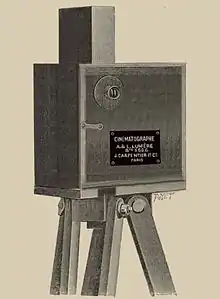| Una paliza en el estado Sarría | |
|---|---|
| Directed by | Ricardo Rouffet |
| Produced by | Carlos Ruiz Chapellín |
Release date |
|
| Country | Venezuela |
Una paliza en el estado Sarría (English: A fight in the Sarría stadium) is a Venezuelan slapstick comedy film created by and starring Carlos Ruiz Chapellín and Ricardo Rouffet. It was first played in the Circo Metropolitano de Caracas on 26 November 1897.[1][2][3]
Background

Ruiz was a showman by trade, and had got into the business of showing films. A variety show he was putting on at the Circo Metropolitano included film as well as zarzuelas and circus acts; in 1897, after the release of the first Venezuelan films in Maracaibo, Ruiz went into business with Ricardo Rouffet to create their own films.[4] One of the people he employed to show films at the Circo was Gabriel Veyre;[5] Veyre's Cinematograph may have been used to make Ruiz' films.[2]
Azuaga García describes Ruiz' choice to hold film showings in a circus as "gaudy", as the previous screenings were held in spectacular theatres and halls, but also suggests it was Ruiz' attempt to "truly bring cinema to the popular classes".[6]
Film screening and content
In November 1897, advertisements in Caracas start promoting "the new Projectoscope", claiming it played in color, and "criollo views", referring to the pair of films made by Venezuelans Ruiz and Rouffet. They also claimed that they would be the first Venezuelan-made films to play in the capital.[1]
Una paliza... was shown before its pair, Carlos Ruiz peleado..., but less is known of it.[2] The "estado Sarría" of the title refers to a location in La Candelaria, Caracas, a neighborhood nicknamed this after a hippodrome in the area that was demolished in 1896, itself named for landowner Julio F. Sarría.[7] The films may have been advertised to the French as showing "real things" from life in the Caracas area.[8][9]
Discussing the director of the pair of films, Sueiro Villanueva proposes that it could have been Rouffet or someone else altogether, acting as director but staying absent from the public screenings.[1] She also discusses how in Venezuela at the time, the arts were housed in social spaces exclusive to the upper classes that participated in them, specifically mentioning the estado Sarría as an area that was derided;[10] Ruiz attempted to change this, by screening in a lower-class space, and by presenting the areas and issues relevant to its occupants' lives in this film.[11]
Details on neither Rouffet nor the films were published in the local press, suggesting that it was critically overlooked.[12]
References
- 1 2 3 Sueiro Villanueva 2007, p. 71.
- 1 2 3 Serrano.
- ↑ de Miranda 2019.
- ↑ Serrano 10 November 2014.
- ↑ Sueiro Villanueva 2007, p. 69–70.
- ↑ Azuaga García 2015, p. 30.
- ↑ Vivas 6 June 2011.
- ↑ Sueiro Villanueva 2007, p. 72.
- ↑ Azuaga García 2015, pp. 32–37.
- ↑ Sueiro Villanueva 2007, p. 23.
- ↑ Sueiro Villanueva 2007, p. 34−36.
- ↑ Sueiro Villanueva 2007, p. 71–72.
Sources
- Literature
- Sueiro Villanueva, Yolanda (2007). Inicios de la exhibición cinematográfica en Caracas (1896-1905) [Beginnings of the cinema exhibition in Caracas (1896-1905)] (in Spanish) (1 ed.). Caracas: Fondo Editorial de Humanidades y Educación, Universidad Central de Venezuela. ISBN 978-9800023952. OCLC 225867560.
- Serrano, Arturo. "The Beginnings of Cinema in Venezuela: The arrival of Cinema in Venezuela (1896–1907)". Universidad Católica Andrés Bello. Retrieved 14 December 2018.
{{cite journal}}: Cite journal requires|journal=(help) - Filmografía 1897-1938 [Filmography 1897-1938] (in Spanish). Fundación Cinemateca Nacional. 1997. ISBN 980-074532-7.
- Azuaga García, Jesús Ricardo (September 2015). Pandemonium: La Filmografia de Roman Chalbaud en el Cine Venezolano: Contexto y Analisis [Pandemonium: The Filmography of Roman Chalbaud and the Cinema of Venezuela] (PDF) (Thesis) (in Spanish). Universitat de Valencia.
- Web
- Serrano, Arturo (10 November 2014). "Los heroes del cine venezolano (Parte I)" [The heroes of Venezuelan cinema (Part 1)]. Vice Versa (in Spanish). Retrieved 13 September 2019.
- de Miranda, Nancy (2019). "Cronología del Cine Venezolano" [Chronology of Venezuelan Cinema] (in Spanish). Observatorio Cine.
- Vivas, Norderlin (6 June 2011). "El urbanista cuenta en pocas páginas de su libro la historia de la zona ubicada en La Candelaria" [The urban planner recounts in a few pages of his book the history of the settled zone in La Candelaria]. Candelaria Viva (in Spanish). Retrieved 13 September 2019.